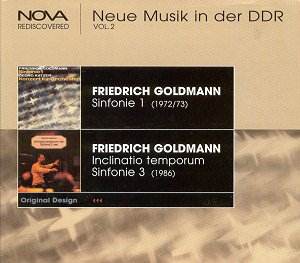Goldmann’s First Symphony, completed in 1973, is in
three sharply contrasted movements following the fast-slow-fast pattern
(and not the other way round as the English translation of the notes
has it). The first movement opens with a bold gesture based on BACH
(B flat-A-C-B) and develops roughly as a sonata form alternating heavily
scored, violent sections and sparser episodes. The slow movement is
some sort of theme and variations alternating dynamic extremes and including
some curious, ethereal sounds and controlled aleatory in a fanciful,
unpredictably unfolding kaleidoscope. The concluding Vivo roughly
resembles a Rondo which again opens with an arresting gesture reminiscent
of that of the first movement. The music moves along with forceful energy,
also momentarily using controlled aleatory, gaining considerable momentum
before collapsing in the final bars. The movement – and the symphony
– ends with a dismissive drum stroke.
Inclinatio temporum was commissioned
to mark the 425th anniversary of the Sächsische Landesbibliothek
and first performed by the Dresden Staatskapelle conducted by Herbert
Blomstedt. This piece might thus have been an occasional showcase for
orchestra, but Goldmann held other views about it. The Latin title of
the piece rather refers to the unfolding character of tempos, and the
music accordingly alternates Allegro and Lento sections, static or rhythmically
nervous sections, in a freely wheeling motion.
The Third Symphony, again in three movements (fast-slow-fast),
is very similar to the First Symphony with, however, a major difference
(or so it seems to me) in that themes tend to have more prominence than
in the First Symphony which often contrasted sharply characterised textures
rather than actual themes. The first movement is cast as an arch, opening
with a brooding, lightly scored introduction leading into a more nervous,
fully scored middle section that builds-up to a climax of considerable
strength before reverting to the opening mood. The central slow movement
is for the most part a long melodic line moving in rarefied air and
interrupted on several occasions by more disturbing chordal sections.
The last movement is another Rondo in which the material progressively
runs riot and is on the verge of total disintegration. Order is briefly,
if artificially, restored by a mighty fortissimo ending.
Goldmann’s music, which was new to me, is clearly of
its time, and might be best described as "updated Berg", by
which I mean that its expressionistic character inherited from Berg
is actualised, as it were, by the use of modern techniques such as unpitched
sounds produced by some untraditional instrument playing and, more than
once, clusters and controlled aleatory, probably learned from Lutosławski.
It is brilliantly and expertly scored, often brassy and with important
percussion parts.
These recordings, originally issued on East German
LPs and now re-issued in CD format, still sound remarkably well; and
the performances conducted by Kegel and the composer have a definitely
authentic ring. This release is an excellent introduction to Goldmann’s
gripping and uncompromising music.
Hubert Culot


